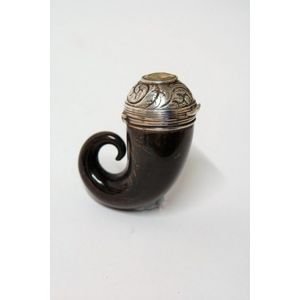Scottish Ram's Horn Vinaigrette with Cairngorm Stone
You must be a subscriber, and be logged in to view price and dealer details.
Subscribe Now to view actual auction price for this item
When you subscribe, you have the option of setting the currency in which to display prices to $Au, $US, $NZ or Stg.
- Gilding - Gilding is a method of ornamentation whereby a thin sheet of gold metal is applied to items made of wood, leather, ceramics, glass and silver for decorative purposes.
For furniture including mirrors, the sheet of gold is usually applied over a coating of gesso. Gesso is a mixture of plaster of Paris and gypsum mixed with water and then applied to the carved wooden frames of mirrors and picture frames as a base for applying the gold leaf. After numerous coats of gesso have been applied, allowed to dry and then sanded a coat of "bole", a usually red coloured mixture of clay and glue is brushed on and allowed to dry, after which the gold leaf is applied. Over time parts of the gilding will rub off so the base colour can be seen. In water gilding, this was generally a blue colour, while in oil gilding, the under layer was often yellow. In Victorian times, gilders frequently used red as a pigment beneath the gold leaf.
Metal was often gilded by a process known as fire gilding. Gold mixed with mercury was applied and heated, causing the mercury to evaporate, the long-term effect of which was to kill or disable the craftsman or woman from mercury poisoning. The pursuit of beauty has claimed many victims, not the least of which were the artists who made those pieces so highly sought after today. - Cairngorm - Cairngorm is a type of smoky quartz, which is a variety of quartz that ranges in colour from light gray to dark brown. It is found in granite rock in the Cairngorm Mountains of Scotland, hence its name, and it is typically found in large clusters. The mineral is relatively hard, with a Mohs hardness of 7, and it is fairly durable, making it a suitable choice for jewellery and decorative objects.
Cairngorm is said to have spiritual and healing properties, it is believed to have grounding energy, and it is thought to help with focus and concentration. It is also said to be a stone of protection and is said to help balance the energy within the body.
The mining and collection of Cairngorms is heavily regulated in Scotland, and it is illegal to remove them from the Cairngorms National Park without a permit.
This item has been included into following indexes:
Visually similar items

An early 19th century silver and ram's horn Scottish snuff mull, the dome lid set with a pale toned cairngorm, leaf scroll cast and engraved decoration, traditional scrolling horn body. Provenance: The Flower Family Collection. Length 7 cm

Victorian 9ct gold, double sided fob locket, with carnelian/bloodstone, photo frames in place but no glass, approx 2.5 cm including bale

10ct white gold sapphire and diamond ring, approx 4.9 grams

A garnet and 18ct gold dress ring. Weight 5g.
